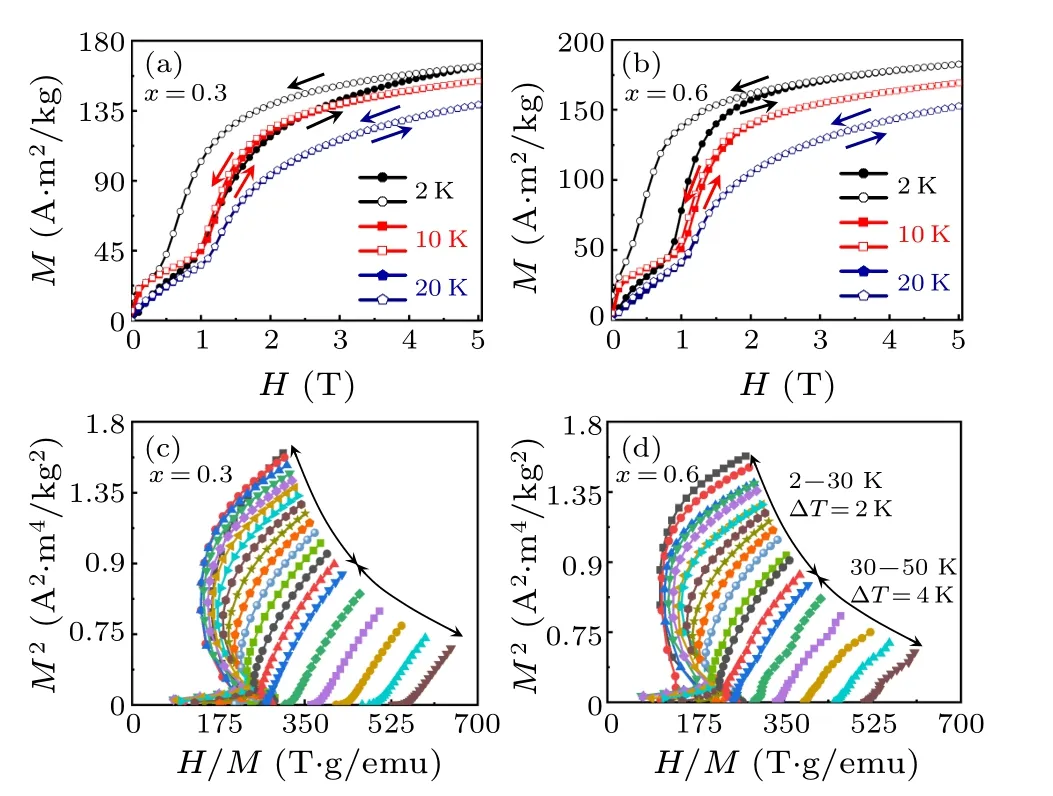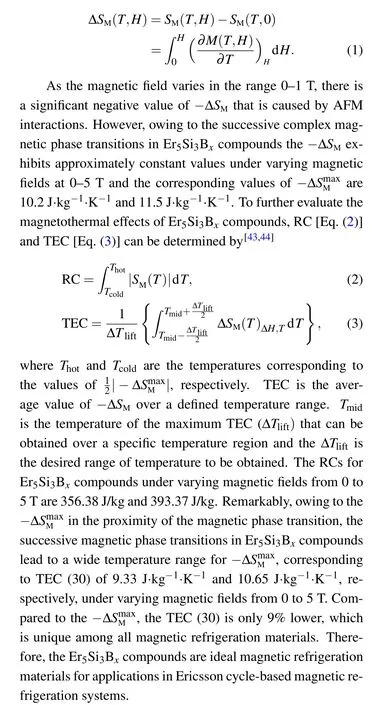Structure,magnetism and magnetocaloric effects in Er5Si3Bx(x=0.3,0.6)compounds
Zhihong Hao(郝志紅), Hui Liu(劉輝), and Juguo Zhang(張聚國)
1School of Rare Earth and New Materials Engineering,Gannan University of Science and Technology,Ganzhou 341000,China
2School of Intelligent Manufacturing and Automotive Engineering,Gannan University of Science and Technology,Ganzhou Innovation Center of Rare earth Permanent Magnet Material Advanced Manufacturing and Intelligent Equipment Technology,Ganzhou 341000,China
3School of Rare Earth and New Materials Engineering,Gannan University of Science and Technology,Ganzhou Key Laboratory of Advanced Processing and Technology Optimization of High Performance Tungsten Base Materials,Ganzhou 341000,China
Keywords: magnetic materials, cryogenic magnetic refrigeration, magnetic phase transition, magnetocaloric effects
1.Introduction
Magnetic materials have gained great interest due to their attractive properties and wide applications.[1–7]The novel solid-state refrigeration technology based on the magnetocaloric effect (MCE) is one of the most promising replacements for conventional refrigeration technologies because of its high efficiency and non-emission of pollutants.[8–23]The MCE is the thermodynamic response of the magnetic material to an applied magnetic field, meaning that the magnetic moment transforms from ordered to disordered(or ordered to ordered) during the imposition of an applied magnetic field,resulting in a change in magnetic entropy.[24]The maximum magnetic entropy changes (-?SmaxM ) generally appear near the magnetic phase transition temperature, so the magnetic phase transition is strongly correlated with the MCE.[25]The-?SmaxM and the refrigeration capacity(RC)are important indicators of the MCE of magnetic refrigeration materials.It is worth noting that the refrigeration region required for cryogenic magnetic refrigeration technology is within 10–77 K.[26]Therefore, it is imperative to develop magnetic refrigeration materials with wide temperature span MCEs for practical applications.
The search for magnetic refrigeration materials with wide temperature span MCE has involved considerable attempts and efforts.The amorphous materials have a wider range of magnetic transition temperature regions owing to the lack of long-range ordering and as a result have a largerδTFWHMof the-?SM.It has been reported extensively that the MCE with largeδTFWHMin amorphous ribbons.[27–30]In addition,the design and development of compounds with different alloy phases with multiple magnetic phase transitions are also considered to be an effective pathway to obtain magnetic refrigeration materials with a wide refrigeration region, such as double-phase ErZn2/ErZn composite and Ho36Co48Al16alloy.[31,32]Meanwhile, materials with a successive magnetic phase transitions are another powerful approach to increasing the refrigeration range.Zhanget al.reported that the Ho3Al2compound hasδTFWHMup to 47 K owing to the existence of spin reorientation (SR) transitions and ferromagnetic (FM)-to-paramagnetic (PM) transitions.[33]However, the available magnetic refrigeration materials remain gaps in performance for applications, where further improvements inδTFWHMare still an unresolved challenge.
Semitelouet al.investigated the magnetic structure of the Er5Si3compound in the temperature range 1.8–120 K by neutron-diffraction measurements.[34]The results show a complex magnetic structure in the Er5Si3compound with two different AFM interactions for wave vectorsK1=[0,±1/4,0]andK2=[0,0,±0.227(2)]at 1.8–13 K and 10–29 K,respectively.More surprisingly, the magnetic interaction of the Er5Si3compound in the temperature range 10–13 K coexists with AFM interaction, and a magnetic phase transition from AFM to paramagnetic occurs at 29 K.The Er5Si3compound with multiple successive magnetic phase transitions is an ideal system for investigating the correlation between magnetic phase transitions and MCEs.Furthermore, addition of the interstitial atom element B modulates the orbital exchange interaction of the rare earth ions for the objective of regulating the magnetic ground state.[35]In this work, the structure,magnetic properties, magnetic phase transitions and magnetocaloric properties of Er5Si3Bx(x=0.3,0.6)compounds are studied.TheδTFWHMvalues of Er5Si3Bx(x=0.3, 0.6) compounds are up to 41.8 K and 39.6 K under varying magnetic fields from 0 to 5 T,respectively.
2.Experimental
The polycrystalline samples were synthesized by melting the elements Er(purity:99.9%),Si(purity:99.9%)and B(purity: 99.9%)ratios on a water-cooled copper bed in a high purity argon atmosphere.The ingots were repeatedly melted four times and overturned after each melting to ensure homogeneity of the sample.Powder x-ray diffraction(XRD)is measured at room temperature using CuKαradiation.Based on a quantum design physical properties measurement system (PPMS-9),the measurements of magnetization of the sample was measured by a superconducting quantum interferometer(SQUID)magnetometer and a vibrating sample magnetometer(VSM).
3.Results and discussions

Compounds Er5Si3B0.3 Er5Si3B0.6 Space group Mn5Si3-type P63/mcm(No.193)a(?A) 8.294 8.289 b(?A) 8.294 8.289 c(?A) 6.205 6.200 V (?A3) 369.658 368.921 Er Wyckoff positions 4d,6g x 2/3,0 y 1/3,0.759 z 1/2,3/4 Si Wyckoff positions 6g x 0 y 0.398 z 3/4 B Wyckoff positions 2b x 0 y 0 z 1/2 Rp (%) 7.364 8.377 Rwp (%) 10.274 12.437 RF (%) 3.133 4.620
Figures 1(a) and 1(b) show the room-temperature XRD pattern of Er5Si3Bxcompounds experimentally obtained with Rietica software refinement.The Mn5Si3-type hexagonal structure(space group:P63/mcm)is adopted to fit the diffraction peaks very well.The parameters of refined and other information about the crystal structure are listed in Table 1.The schematic crystal structure of Er5Si3Bxcompounds are illustrated in Figs.1(c) and 1(d).There are two inequivalent Er atoms in Er5Si3Bxcompounds.The Er atom at the first site is located at the Wyckoff positions 6g(0, 0.759, 3/4) and the six 6gpositions of the Er atoms form an octahedral structure.The B atom is located in the center of the octahedron with the corresponding Wyckoff position 2b(0, 0, 1/2).The Er atom in the second site is located at Wyckoff position 4d(2/3, 1/3,1/2) and coordinates with the six surrounding equivalent Si atoms located at Wyckoff positions 6g(0, 0.398, 3/4).The doping of B element lead to a distention of theaandbaxis of Er5Si3Bxcompounds compared to the Er5Si3compound,while thecaxis shows a shorter length.The variation of the lattice constant will cause a dramatic change of the orbital exchange between the elements in the system,which will exhibit complex and fascinating magnetic properties.[36]
In order to understand the magnetic and magnetic phase transitions, the temperature-dependent magnetization curvesM(T) for Er5Si3Bxcompounds were obtained by using field cooling(FC)and zero-field cooling(ZFC)modes,and the corresponding results are shown in Figs.2(a)and 2(b).The results show that magnetizationMincreases gradually with decreasing temperature,peaks around 30 K,and decreases briefly before rising sharply again.These indicate that the PM-to-AFM phase transition occurs around 30 K in Er5Si3Bxcompounds.However, the magnetic behavior of Er5Si3Bxcompounds at temperatures below 30 K is still unclear and therefore theM(T) curves under different magnetic fields are shown in Figs.2(c) and 2(d).It can be clearly observed that a typical field-induced metamagnetic transition from the AFM state to the FM state occurs around 10 K and 30 K for Er5Si3Bxcompounds as the magnetic field increases.The results show that the strengths of the exchange interaction between the two AFM states around 10 K and 30 K are different, based on the critical magnetic field required for field-induced metamagnetic transition from the AFM to the FM state.The AFM state around 10 K requires a magnetic field higher than that at least 4 T to undergo the field-induced metamagnetic transition from AFM to FM, while the antiferromagnetic state around 30 K undergoes a similar transition at an applied magnetic field of more than 1.8 T.However,the magnetic structure in the temperature range 10–30 K is still complicated as a result of the competition between the low-temperature AFM I(~10 K)and the high-temperature AFM II(~30 K),with magnetic interactions similar to those of ferrimagnetic state(FiM).In the PM region, the inverse dc susceptibility (1/χ) follows the Curie–Weiss law as shown in Figs.2(a)and 2(b)insets.The 1/χ–Tcurves are based on the Curie–Weuss fits to PM Curie temperatures(θCW)of 18.7 K and 17.9 K in Er5Si3Bxcompounds.The positiveθCWindicates that the AFM interaction in Er5Si3Bxcompounds is unstable,and similar phenomena have been observed in other AFM compounds as well.[37,38]

The isothermal magnetizationM(H) curves of Er5Si3Bxcompounds were measured to further understand their magnetic and magnetic phase transitions, the curves for different temperatures can be observed in Figs.3(a)–3(d).It can be clearly seen thatMof Er5Si3Bxcompounds first rises sharply at 2 K and then shows a linear increase,Magain increases sharply with further increase in the magnetic field and gradually tends to saturation.The same phenomenon can be observed in the EuSe compound, which may be due to the successive magnetic phase transitions from AFM I to FiM, then to AFM II.[39,40]In addition, theM(H)curves exhibit a clear crossover around 10 K and 30 K,which is caused by AFM interactions.In the PM temperature region(temperatures above 30 K),Mincreases linearly with increasing magnetic field,which is consistent with the results obtained above.It is well known that there is a close correlation between the MCE and the type of magnetic phase transition.Thus, theM(H)curves with increasing and decreasing magnetic field for different temperatures are shown in Figs.3(a)and 3(b).The results show that there is significant hysteresis in Er5Si3Bxcompounds at 2 K, which is due to the transition from AFM I to FiM.As the temperature increases, only a slight hysteresis exists at 10 K.Remarkably, the hysteresis disappears almost completely at 20 K,indicating that the magnetic phase transition from FiM to AFM II is reversible.Based on the Banerjee criterion the Arrott plots indirectly obtained from theM(H)curve was applied to further determine the order type of magnetic transitions of Er5Si3Bxcompounds.[41]The order of the magnetic phase transition is determined by the negative or positive slope of the curve of the Arrott plots corresponding to the first and second order phase transitions, respectively.As the temperature is below 30 K,the Arrott polts exhibits a distinct S-shape,indicating the presence of both first-(AFM I to FiM)and second-order(AFM II to FiM)magnetic phase transitions in Er5Si3Bxcompounds as shown in Figs.4(c)and 4(d).



The magnetic entropy changeSM(T,?H) for Er5Si3Bxcompounds have been determined based on the Maxwell thermodynamic relation for the variation of the magnetic field in the range 0–5 T, the corresponding results are shown in Figs.5(a)and 5(b).[42]

4.Conclusions
In summary, we have synthesized polycrystalline Er5Si3Bx(x= 0.3, 0.6) compounds and investigated their structure,magnetic properties,magnetic phase transitions and MCEs.The lattice constant change caused by the doping of element B affects the orbital exchange interactions for Er3+ions,which leads to the interesting and complex magnetic properties observed in the Er5Si3Bx(x=0.3, 0.6) compounds.In addition, the field-induced metamagnetic transitions are observed with increasing magnetic fields.The-?SmaxM and RC of Er5Si3Bx(x=0.3, 0.6) compounds are 10.2 J·kg-1·K-1,356.3 J·kg-1·K-1and 11.5 J·kg-1·K-1,393.3 J·kg-1·K-1under varying magnetic fields from 0 to 5 T.The successive magnetic phase transitions cause the-?SMto be nearly constant over a wide temperature range,with corresponding TEC(30)of 9.3 J·kg-1·K-1and 10.6 J·kg-1·K-1.Our results show that Er5Si3Bx(x= 0.3, 0.6) compounds are optimally suitable magnetic refrigeration materials for application in Ericsson cycle-based magnetic refrigerators.
Acknowledgment
This work was supported by Science and Technology Research Project for Education Department of Jiangxi Province,China(Grant No.GJJ218509).
- Chinese Physics B的其它文章
- The application of quantum coherence as a resource
- Special breathing structures induced by bright solitons collision in a binary dipolar Bose–Einstein condensates
- Effect of short-term plasticity on working memory
- Directional-to-random transition of cell cluster migration
- Effect of mono-/divalent metal ions on the conductivity characteristics of DNA solutions transferring through a microfluidic channel
- Off-diagonal approach to the exact solution of quantum integrable systems

